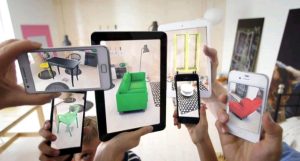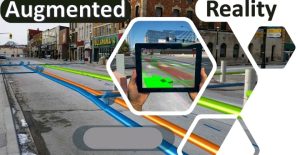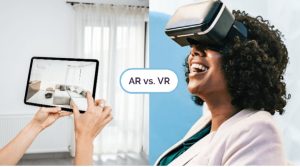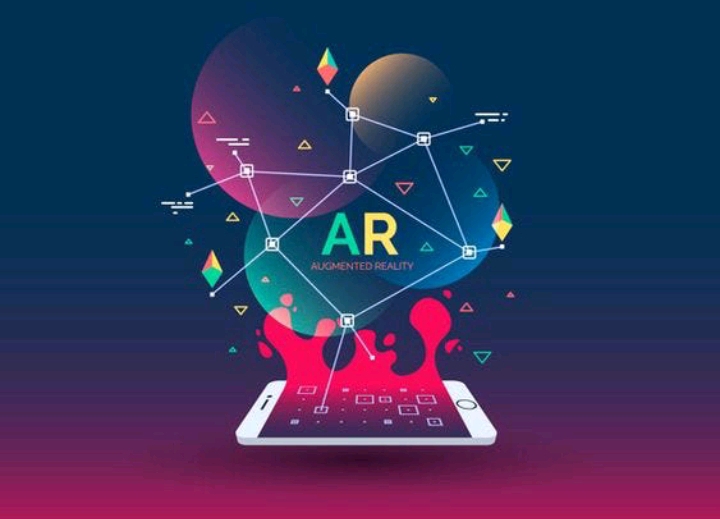Augmented Reality (AR) technology was invented in 1968 by Ivan Sutherland, a Harvard professor and computer scientist. He created the first head-mounted display called ‘The Sword of Damocles’. However, Tom Caudell, a Boeing researcher, was the one who coined the term ‘augmented reality’ in 1990.
In augmented reality, the real-world environment is enhanced with computer-generated visual elements, sounds, and other stimuli. Different fields like business, education, architecture, gaming, and so on, also use AR.
Does Augmented Reality (AR) sound like a strange term to you? Does it feel like rocket science? In this article, we are going to delve into the meaning of AR, industries where AR is used, plus some real-time examples, and the disparities between augmented reality (AR) and virtual reality (VR). Read on to unlock a basic understanding of AR.
The Meaning of Augmented Reality
Augmented Reality is the improved version of the real world, accomplished via the use of computer-generated digital information. In other words, it is the process of overlaying digital information into the real world that you see. Furthermore, involves visual sounds and other sensory elements. This means that it adds images, sounds, or even things you can feel to your real environment.
Augmented Reality makes use of computer hardware and software such as screens, apps, or projections to integrate digital information with a real-time environment. It places its focus on the real world. Usually, you can interact with these digital stuff.
5 Industries That Use Augmented Reality With Examples
Augmented Reality (AR) was once restricted to science fiction movies but has now become a practical tool across diverse industries. It is now used in making better user experiences and redefining the way businesses conduct their activities. AR is also making waves in different fields from entertainment to shopping, even in the healthcare sector.
Without further ado, let’s dive into these industries where AR is making significant headways.
1. Augmented Reality (AR) in Entertainment:
To create captivating experiences, the entertainment industry, including live concerts and games, has now embraced augmented reality. Live shows enhanced by AR offer fans the chance to witness holographic performances, eroding the distinction between the physical and virtual worlds. Microsoft HoloLens can be used to do this. It is an AR headset that is used in live concerts to develop a holographic experience. This helps to link the virtual and physical worlds.
Pokemon Go, in the gaming field, has made AR mainstream, giving players the chance to interact with virtual creatures in the real environment. Pokemon Go is a mobile game that enables players to bring Pokemon into the real world. Furthermore, layers explore their environment to locate and capture virtual creatures. This enables playtime to be more interactive.
2. Shopping and Retail:

Augmented Reality (AR) has significantly changed the retail sector by providing an immersive and interactive experience for users. Retail giants like Amazon and Gucci App leverage AR, giving customers the chance to try out furniture virtually and shoes before making a purchase. Through this, the shopping experience is well enhanced. Likewise, it decreases the chances of returns.
Amazon uses AR in its Room Decorator, allowing users to place furniture in their homes virtually before making a purchase. Also, it allows you to add multiple items at the same time. This implies that you can remodel your entire place in AR. Customers are able to see how items will look in their space before making any purchase.
Gucci’s App AR tool allows customers to try out shoes to get a feel of how they would look once on. It is noteworthy that Gucci is the first luxury brand to incorporate AR into its social media campaigns.
3. Augmented Reality (AR) in Education:
Augmented Reality (AR) is used in educational apps and platforms. This help learners to bring textbooks to life. This allows students to explore 3D models and interactive content. Through AR, students can bring their drawings to life using 3D. They can also take virtual tours to landmarks or faraway locations like the Pyramids of Egypt or the Great Wall of China without having to leave their classrooms.
CoSpaces Edu gives students the opportunity to not only explore AR but also, develop their own experiences in any subject area. Also, they can add audio and code characters. In addition, they can upload their 360-degree images to projects.
Anatomy 4D utilizes the AR tool to bring Anatomy lessons to life. Students can interact with the 3D model of the human body to grasp a better understanding of anatomy and physiology.
4. Engineering and Architecture:

Engineers and architects use AR for planning and to visualize a design. Through AR tools, professionals can overlay digital models onto physical spaces. This gives room for real-time assessments and adjustments.
ARki as an augmented reality (AR) tool for architects, allows for importing 3D animations and several 3D models for a single project. It also gives the chance for real-time simulations of shadows and lighting.
Magic Plan is another AR tool for architects that enables them to produce floor plans. Also, they can scan a room using the device’s camera and it automatically delivers accurate and crisp floor plans either in 3D or 2D. In addition, they can generate high-quality interior drawings. These can be shared with contractors, teams, and clients.
5. Augmented Reality (AR) in Healthcare:
Augmented Reality (AR) has resulted in substantial improvement in the healthcare sector, from surgical planning to patient care. It offers accuracy and guidance. AR can be a great source of help to medical students during anatomy lessons.
The AR technology in AccuVein helps healthcare experts find veins for blood draws and injections. In addition, the device projects a map of veins onto the skin of the patient, enhancing the precision of medical processes.
Differences Between Augmented Reality (AR) and Virtual Reality (VR)

People often confuse AR with VR but they are actually different. Let’s take a look at a few of their differences.
- Augmented Reality (AR) enhances the real world. This implies that it adds extra features to your view of the world around you. In contrast, virtual reality creates an entirely new and simulated world.
- Augmented reality superimposes the computer-generated digital information into your real world. On the other hand, virtual reality takes you into a computer-generated world. You don’t see your physical surroundings while operating in VR.
- Augmented reality often uses smartphones or tablets, while virtual reality utilizes special headsets that cover the eyes and sometimes incorporate additional items like hand controllers. Although some AR uses special headsets, it is not common.
The Bottom Line
Augmented Reality (AR) is a technology that enhances users’ experiences and shifts their perspective by overlaying a real-world environment with a computer-generated one.
In addition, it is a form of mixed reality, integrating the real world with digital visual elements. This is in contrast to virtual reality which is entirely digital.
